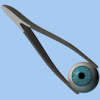All Activity
- Today
-

2001 Slit-Scan Effects Simulated in A:M? With MUFOOF?
robcat2075 replied to fraizer's topic in Work In Progress / Sweatbox
How many cores does your CPU have? You could be using them with NetRender. - Yesterday
-
2001 Slit-Scan Effects Simulated in A:M? With MUFOOF?
fraizer replied to fraizer's topic in Work In Progress / Sweatbox
Not using Netrender. -

2001 Slit-Scan Effects Simulated in A:M? With MUFOOF?
robcat2075 replied to fraizer's topic in Work In Progress / Sweatbox
Are you using Netrender? -
2001 Slit-Scan Effects Simulated in A:M? With MUFOOF?
fraizer replied to fraizer's topic in Work In Progress / Sweatbox
Good observation, Robert. I was thinking "no" as well. After doing some experimenting with a narrower soft slit, I decided to go with the original approach demo'ed above. My concern was that in the course of applying the slit artwork decal I had to scale vertically and horizontally to fit the model; scaling horizontally narrowed the slit and reduced the amount of soft-edge -- not easy to make artwork 4' tall by 1" wide, not for me anyway. The real test I think is how the soft edge approach works over the span of the artwork, and how it animates. A sequence is rendering now. The soft edge does add to the render time... Here is a new set of files; a new Slit-screen/Artwork model using a TGA as a transparency map, renamed Action files, and new Cho and render Preset files; 2001 artwork is the same as above: soft-slit-screen-2001artwork-system01.mdlsoft-slit-artwork01.tgasoft-slit-screen-backward-2001-artwork.actsoft-slit-screen-backward-system-60sec.actsoft-slit-scan-backward-indy-2001-artwork-60sec-01.cho2001-Soft-Slit-Preset.pre -

2001 Slit-Scan Effects Simulated in A:M? With MUFOOF?
robcat2075 replied to fraizer's topic in Work In Progress / Sweatbox
My guess is "no" "Slitscan" is essentially a motion blur effect, capturing any and all the light while a shutter is open. But, as you know, ray tracers like A:M reproduce only the light of an infinitely brief instant of time, and can only approximate the "open shutter" by rendering a series of instants in succession and averaging them together. We call this multipass, other software may call this multi-sampling or super-sampling but it's all the same thing. There is another motion blur technique however. If you turn off Multipass but still select "motion blur", A:M calculates an internal "vector buffer" which stores a direction and velocity for every pixel. After the single-instant-of-time image is completed, every pixel is then given a straight line blur in the direction and magnitude indicated by its vector buffer counterpart. For small amounts of motion blur typical in character animation it looks very similar to the multipass result and takes only a fraction of a second to do. But it can't account for motion that is not strictly linear, that might have a visible arc within one frame, nor can it account for the effect of your slitscan device where different portions of the artwork are revealed over time. It would note that your artwork is moving but only apply blur to the portion that was visible at the instant of render. -
2001 Slit-Scan Effects Simulated in A:M? With MUFOOF?
fraizer replied to fraizer's topic in Work In Progress / Sweatbox
A quick and dirty test of the transparency map/soft-edged slit idea shows promise. Needs refinement, but better and better. Good thinking, Robert. - Last week
-

2001 Slit-Scan Effects Simulated in A:M? With MUFOOF?
robcat2075 replied to fraizer's topic in Work In Progress / Sweatbox
Yup, Render Presets are new-in-v16 feature https://forums.hash.com/topic/50199-v19-v18-v17-new-features-and-enhancements/?do=findComment&comment=424030 -
2001 Slit-Scan Effects Simulated in A:M? With MUFOOF?
fraizer replied to fraizer's topic in Work In Progress / Sweatbox
Robert, Render Presets -- version and platform vagaries, oh my. I run v15 on my MacBkPro and do a lot of "development" in that environment. The v15 Render to File window does not have any Preset buttons at all. I always have to do the "Tools>Options>Rendering>Use Settings from>Camera" routine when I go to render anything as the default is "Use this Dialog." I do some work and long renders in v17 on a MacMini. The v17 Render to File window looks like this: The button names are not as revealing as your window shows. That's why I have never used them. Here is the preset file saved in v17, I think: 2001-slit-scan-Preset.pre Thanks for the EXR info. That experimentation will have to wait for another day. I want to explore your idea of a transparency map for the slit. -
Late to the show. That animation is boring. Just slow panning over some graphical morphs. Guess AI isn't going to take too many jobs :)
-
JasonNEK joined the community
-

2001 Slit-Scan Effects Simulated in A:M? With MUFOOF?
robcat2075 replied to fraizer's topic in Work In Progress / Sweatbox
Users will need to set A:M to "Tools>Options>Rendering>Use Settings from>Camera" which is entirely doable if they have been alerted. For future reference, Render Presets are saved and loaded from the Render to File Settings panel. Preset snapshots every render parameter. They are useful for migrating settings to a new camera, saving favored settings, and most especially, taking settings to NetRender which does not seem to have a "Use Settings From:" option. EXR stores pixel info in a variety of floating point formats rather than 8-bit integers. It permits values that exceed pure white (AKA 1.0 or 255/255) or that fall below 1/256 to be accurately preserved. This allows extreme adjusting/correction of levels and color in post without the banding artifacts we get from integer formats. It's possible for an EXR environment map to have an image of the Sun that is as bright as the Sun in comparison to other parts of the image. EXR also has numerous options for compression including ostensibly lossless ones. And many other wonders. A:M "Composite Projects" can work with OpenEXR but the workflow is a bit dense. I'll note that A:M can render to 16 bit PNG which will also give you increased processing latitude, although it still doesn't handle values greater than 1.0 -
2001 Slit-Scan Effects Simulated in A:M? With MUFOOF?
fraizer replied to fraizer's topic in Work In Progress / Sweatbox
Thank you, Robert. Thank you, Fuchur. Banding -- a soft slit, that's an excellent idea. I will play with that. Not sure what a render "preset" is, other than the settings contained in the Cho file I posted. (I don't use Projects in my projects, that's why I posted individual files...). Re: EXR and exposure: A few years ago, I was working on a project with Rob Blalack and we discussed using EXR for something we were trying to do, but that's as far as it went; and that is the limit of my understanding of EXR -- very limited. I have found that a broad range of Keylight intensities works, with varying degrees of success; same is true for Pass and Blur values; to a large degree it is a matter of taste. I am very, very curious to know if there is another way to do the slit-scan technique in A:M without using MUFOOF... -

2001 Slit-Scan Effects Simulated in A:M? With MUFOOF?
Fuchur replied to fraizer's topic in Work In Progress / Sweatbox
Very, very nice :). -

2001 Slit-Scan Effects Simulated in A:M? With MUFOOF?
robcat2075 replied to fraizer's topic in Work In Progress / Sweatbox
That looks very cool, Joseph! I was 8 when "2001" came out. When my parents announced we were going to see a science-fiction movie I thought they were insane. We're going to watch a guy in a rubber monster suit? And what is "2001"? Is that like "007"? But the movie was absolutely astonishing. I was building cardboard-box spaceships with robot arms in the basement for years after that. Suggestions: -Could you save a render "preset" from the render settings and post that so we can use the same? -Banding... you may be able to reduce the multipass banding by using a slit with soft edges. That could be done with a transparency map for the slit instead of a modeled slit. -Exposure... If you render to OpenEXR and have an OpenEXR-aware post app that will give you enormous room to tinker with levels without having to get it exactly right in the render. -
-
Recent YouTube wanderings led me to some videos about 2001, the making of the Star Gate sequence, and so on, which got me thinking… 2001 is among my all-time favorite movies. It is film qua film, not merely a novel thrown up on the screen. I saw 2001 at the Cinerama Theater in LA in 1968, with my college comrade and long-time friend, the late Robert Blalack, who received the VFX Oscar for Star Wars (1977). To say that we were mind-blown would be the understatement of understatements. These days, movie editing programs and software packages usually have some form of the slit-scan effect in their bags of tricks. But why use them when I might be able to re-create a virtual version of the Douglas Trumbull set-up in A:M? Down the rabbit hole I went with internet research on 2001, Trumbull, and slit-scan techniques. Trumbull set-up (details vary depending on source): Camera with open shutter on 15’ track. Slit-scan structure to support 4’ tall slit (I have not found width of slit documented anywhere) and Artwork moving behind slit; slit is just off-center (Trumbull has said there were 2 slits, one for the left pass, one for the right pass). Artwork greater than 4’ tall and as wide as you want to make it — many feet. Camera moves down track from 15’ away to 2” (or so) toward Slit/Artwork over a period of 1 minute while Artwork is moved approx. 8” horizontally; Trumbull mentions that the camera was panned slightly during this move. The result is one frame of exposed film, either the left half or right half of frame, depending. Rinse and repeat. First proof of concept in A:M: I made a simple model, a panel with a slit in it, to scale, and an artwork panel set just behind the slit. In the Cho, I placed the Camera 15’ away from the Slit-screen/Artwork model. I keyframed the camera to move toward the model while moving the artwork behind the slit. After rendering a series of frames, I composited the frames into a single frame and could see that I was getting something like the desired image stretch/smear of the slit-scan technique. So the approach sort of worked, but the method was tedious. How to “hold the shutter open” for a single frame during the camera move? Then I remembered the MUFOOF (Multiple Frames in Only One Frame) technique posted by Xtaz in 2005. As the Camera cannot be moved toward the Artwork within the MUFOOF action, I realized I would need to move the Slit-screen/Artwork model toward the Camera. I made an action to do that, did test renders, and got strange results. So I made an action that ran the set-up backward, moving the Slit-screen/Artwork model from 2” in front of the Camera to 15’ away, and got good, predictable results. Also, the Artwork cannot be moved within the MUFOOF action and have its new location available for the next frame. A second action is needed to move the Artwork between frames. I did many test renders of the backward MUFOOF Slit-screen/Artwork model move with Artwork moves between MUFOOF frames, while tweaking the Multi-Pass and Motion Blur values, and got some beautiful results. An example, using a 2 slit model: The light trails move, scintillate, but the dynamic acceleration characteristic of the Star Gate sequence was missing. The final ah-ha moment was realizing I could move the Slit-Screen model element across the Artwork as the model travels away from the Camera. That worked. Here is a wireframe of the set-up: Once I had a working slit-scan system, I wanted to see what actual 2001 artwork would produce. That artwork is long gone. But a couple of clever people have managed to deconstruct/reconstruct it through some coding wizardry. My 2001 Artwork was extracted from YouTube video https://www.youtube.com/watch?v=meEhkceeA94 and website https://www.seriss.com/people/erco/2001/ which reconstructed the original graphics by taking strips from each frame and placing them side by side. An example still from a render using the reconstructed artwork, left side of frame only: As my set-up has the slit on the left side of the model and the artwork moves from left to right and the Slit-screen/Artwork model moves away from the Camera, the rendered sequence moves away from the viewer unlike the actual Star Gate sequence. No matter. Modern movie editing software supports flipping sequences horizontally, vertically, and end-for-end. Here is the link to a short version of the Star Gate sequence as done in A:M, rendered at 720p and up-res’ed to 1080p, including a Ligeti-esque soundtrack: https://youtu.be/P4kflu1okxE Two issues with Multi-Pass that do not exist with real film emulsion: Brightness of image diminishes from outside edges inward as passes progress; I used high intensity values (2000 - 4000%) for the Keylight to compensate which causes a somewhat blown-out result; kind of OK because the overall effect in 2001 is blown-out. Banding from over-lapping passes; no complete remedy that I know of. Think of it as a feature, not a bug. High contrast artwork mitigates the issue somewhat. Here are the files: slit-scan-backward-indy-2001-artwork-60sec-01.chosingle-slit-screen-2001artwork-system01.mdldouble-slit-screen-backward-system-60sec.actdouble-slit-screen-backward-2001-artwork.act I am working on another slit-scan experiment using Mandelbrot Set artwork created by another college comrade who was also along for the 2001 ride back in 1968. I will post that item in the near future. Best to all.
-
Get live answers to your A:M questions at Live Answer Time at Noon CDT, Saturday June 15 2024 "Teena" cartoonist Hilda Terry was born on this day in 1914.
-
Desmondmah joined the community
-
cassiebender joined the community
-
John could you save a Render Preset after you have made all your render settings and post that file here so i can try a render with your same settings.
-
johnmichae1 joined the community
-
when I am rendering this getting starnge shadow Tinmed.avi tinme2.prj
- Earlier
-

WIP - Pennsylvania Station (sort of)
Rodney replied to R Reynolds's topic in Work In Progress / Sweatbox
Great sense of scale in all of these models @R Reynolds -
-
-
In the Radiosity example, I set the Intensity parameter very high...200... so that the effect could not be overlooked. Lower values are probably more typical in careful lighting situations. This compares several Intensities. Note that a 0 intensity looks just like a conventional render. The bottom row is the same images with a 1.8 gamma applied. These fine adjustments are where you want to know your monitor is carefully calibrated and that your audience's monitors are so also... which we never know!
-
Wow..fantastic answers. I can't wait to study and test this! Thanks!
-
There is some similarity in appearance, although the process is quite different. Here is a test scene. It is an open-top box with a sphere inside it. A single kleig light is above and behind the box. The camera is inside the box, pointing toward the sphere and back wall. A conventional render from the camera view gives this result. Every point in the scene is either illuminated by the kleig light or is black, for lack of illumination. Global Ambience (AKA Ambient Occlusion) simulates an infinity of kleig lights from every possible direction. This all-over light reaches more parts of the scene; the surfaces that are more exposed to it are more illuminated and the surfaces that are more "occluded" from it are darker. Some surfaces like the bottom of the sphere and the area below the sphere are still completely untouched by this light and remain black. Global Ambience ON, kleig light OFF: In both of the above cases, if a point is not directly exposed to some source of light, it is unlit and black. Radiosity (other programs call this "Global Illumination") works by calculating light that bounces off surfaces in the scene, as real light does. The blue wall, which is completely hidden from the kleig light , is still illuminated by light bouncing off other surfaces in the scene. Light bouncing off the red and blue walls spill some color onto nearby surfaces. The bottom of the sphere, although cut off from direct light, is illuminated now. Global Ambience OFF, kleig light ON, Radiosity ON: This PRJ has the three chors above. To render them properly, you'll need to do Tools>Options>Rendering>Use Settings from>the Camera AOvRadDemo005.prj





























